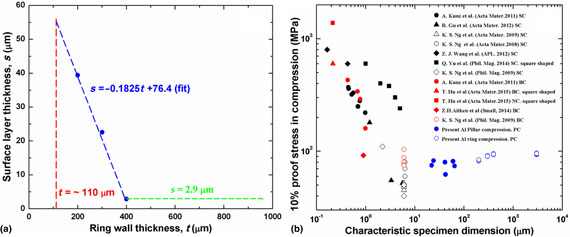Article contents
Mechanical response of mesoscopic aluminum rings under uniaxial compression
Published online by Cambridge University Press: 26 April 2018
Abstract

The strength of materials exhibits size effects at sample dimensions <1 mm. In the literature, two trends are identified in the length scale spectrum: smaller is stronger at <10 µm; larger is stronger at >500 µm. The dimension at which the transition between these two trends occurs remained unclear. We study this mesoscopic scale (20–400 µm) by examining the compression response of ring and pillar-shaped Al specimens. Integrating present results with literature data, we provide Al's compression response in a “master curve” fashion. We demonstrate the inadequacies of the classical surface layer model, and suggest directions for future studies.
- Type
- Research Letters
- Information
- Copyright
- Copyright © Materials Research Society 2018
References
- 5
- Cited by





